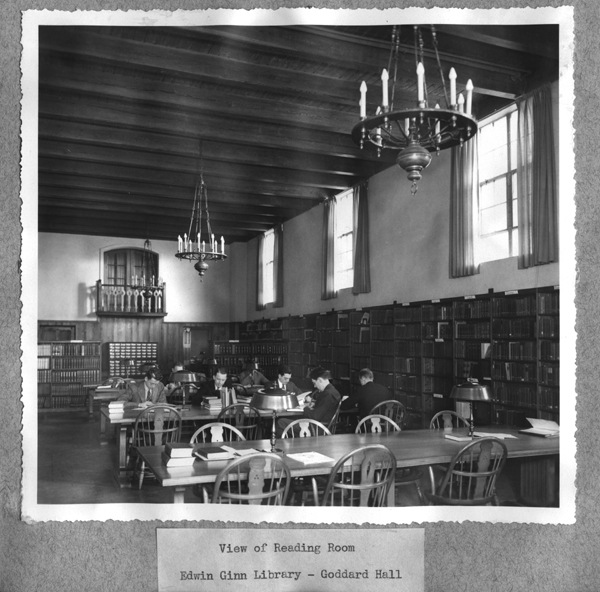The nature of a modern Ginn Library
Fletcher’s Ginn Library reference librarian, Ellen McDonald, and I share something in common: we both have had two Fletcher careers. In Ellen’s case, both careers (separated by a long gap) were in the library. I asked her to reflect on the amazing change to the library’s role in the sharing of information from her first career to her second.
Libraries are undergoing rapid change and Fletcher’s Ginn Library is no exception. Thirty years ago, the central feature of the library’s Reference Room was eight sections of 72-drawer catalog cabinets. Computers were tucked into a small room which contained four boxy terminals. Students worked at the Reading Room tables or settled into individually assigned study carrels in the stacks. The on-duty Reference Librarian could be found seated at a centrally located desk with a phone and small ready-reference book collection at hand. The general rule of library etiquette was QUIET.
Today, Ginn Library looks and feels very different. While quiet study space continues to be one of the library’s main attractions, Fletcher students today also require collaborative work space. One of the major features of a Fletcher education is networking: sharing knowledge and the creation of lifetime bonds. Changes in technology, research, teaching, and learning have created a very different context for the missions of academic libraries. As scholarship has grown more interdisciplinary, so has the library’s space evolved to facilitate this transition. Today, Ginn is filled with furniture and spaces that are easily adapted to changing research and study styles. The lower stacks area is now a group study lounge, equipped with large screens and whiteboards. The group project areas are abuzz with students interacting, teaching one another in peer-to-peer workshops and collaborating on group assignments.
Information abundance due to mass digitization means that librarians have more work guiding users to the right sources — scholarly content can get lost in the internet flood. Increasingly, librarians serve as curators of information, determining what to collect, store and deliver…and what not to collect. With information-on-demand and instant information gratification the rule of the day, googlized students are less likely to need the fact-checking skills of a Reference Librarian. Increasingly, students and professors turn primarily to Ginn’s librarians for in-depths consultations about research papers, Capstone Projects, internships, dissertations and field work. Many of these reference transactions have moved from a reference office and phone to an online chat or e-mail. Some of our GMAP students prefer the technological synthesis of old and new interactions that Skype offers…a digital “face-to-face” meeting.
 The impact of digital technology pervades most every library function. The library’s oak catalog disappeared twenty years ago and large portions of the collection have followed it into the virtual world. The ability to digitally obtain material via interlibrary loans has exploded the physical limitations of the library’s collection. Ginn has less need to store large runs of journals, as digital libraries and resource-sharing consortia proliferate. But walk into the Reading Room, and you’ll be transported back in time to Fletcher’s beginnings when the photograph to the right was taken. Some things will never change. The walls here still contain the same treaty collections, state papers and legal treatises. Portraits of former deans still line the walls. The library as a physical place continues to be a hub of learning and a connection to our past and shared history. Despite all that has changed over the decades in Ginn Library, visiting alumni will discover a library space that continues on as the heart of the Fletcher School — a place for connection, collaboration and contemplation.
The impact of digital technology pervades most every library function. The library’s oak catalog disappeared twenty years ago and large portions of the collection have followed it into the virtual world. The ability to digitally obtain material via interlibrary loans has exploded the physical limitations of the library’s collection. Ginn has less need to store large runs of journals, as digital libraries and resource-sharing consortia proliferate. But walk into the Reading Room, and you’ll be transported back in time to Fletcher’s beginnings when the photograph to the right was taken. Some things will never change. The walls here still contain the same treaty collections, state papers and legal treatises. Portraits of former deans still line the walls. The library as a physical place continues to be a hub of learning and a connection to our past and shared history. Despite all that has changed over the decades in Ginn Library, visiting alumni will discover a library space that continues on as the heart of the Fletcher School — a place for connection, collaboration and contemplation.